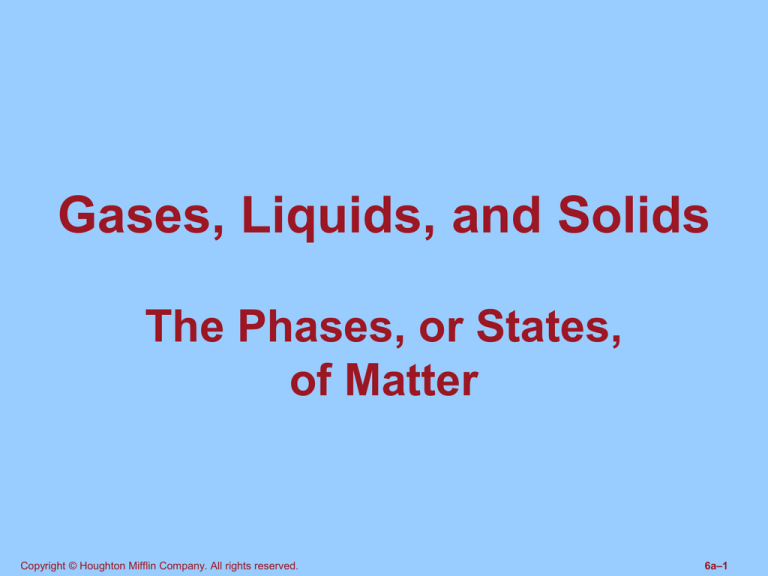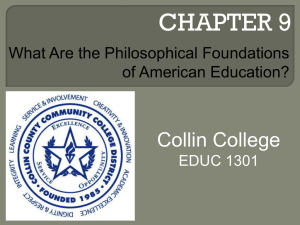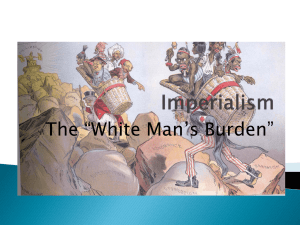
Gases, Liquids, and Solids
The Phases, or States,
of Matter
Copyright © Houghton Mifflin Company. All rights reserved.
6a–1
Physical States of Matter
A solid has a definite shape and a definite
volume.
A liquid has an indefinite shape - it takes the
shape of its container – a definite volume.
A gas has an indefinite shape and an indefinite volume – it expands to fill its container.
Copyright © Houghton Mifflin Company. All rights reserved.
6a–2
Table 6.1
Distinguishing Properties of Solids,
Liquids, and Gases.
Copyright © Houghton Mifflin Company. All rights reserved.
6a–3
6.1 The Kinetic Molecular Theory
of Matter
1. Matter is composed of tiny particles.
2. The particles are in constant random
motion and possess kinetic energy.
3. The particles interact with each other
through attractions and repulsions and
possess potential energy.
Copyright © Houghton Mifflin Company. All rights reserved.
6a–4
6.1 The Kinetic Molecular Theory
of Matter
4. The velocity of particles increases with
temperature, as does their kinetic
energy.
5. The particles transfer energy to each
other through elastic collisions.
Copyright © Houghton Mifflin Company. All rights reserved.
6a–5
Figure 6.2
Upon release, the steel ball on the left
transmits its kinetic energy through elastic collisions to the ball on the right.
Copyright © Houghton Mifflin Company. All rights reserved.
6a–6
6.2 Kinetic Molecular Theory and
Physical States
In solids, cohesive forces (potential energy)
dominate over disruptive forces (kinetic
energy).
In liquids, cohesive forces (potential energy)
and disruptive forces (kinetic energy) are
similar in magnitude.
In gases, disruptive forces (kinetic energy)
dominate over cohesive forces (potential
energy).
Copyright © Houghton Mifflin Company. All rights reserved.
6a–7
(a) Particles in a solid (atoms, molecules, or ions) are
close together and vibrate about fixed sites.
(b) Particles in a liquid, though still close together,
freely slide over one another.
(c) Particles in a gas are in constant random motion,
each particle being independent of the others present.
Copyright © Houghton Mifflin Company. All rights reserved.
6a–8
When a gas is compressed, the amount of empty
space in the container is decreased. The size of the
molecules does not change; they simply move closer
together.
Copyright © Houghton Mifflin Company. All rights reserved.
6a–9
6.3 Gas Law Variables
Volume
Expressed in milliliters or liters
Temperature
Expressed in K (°C + 273 = K)
Amount
Expressed in moles (n)
Pressure (Force per unit area, F/A)
Expressed in atmospheres, mm Hg, or torr
Copyright © Houghton Mifflin Company. All rights reserved.
6a–10
Figure 6.5
The essential components
of a mercury barometer
are a graduated glass
tube, a glass dish, and
liquid mercury.
Copyright © Houghton Mifflin Company. All rights reserved.
6a–11
6.4 Boyle’s Law:
A Pressure-Volume Relationship
Copyright © Houghton Mifflin Company. All rights reserved.
6a–12
6.4 Boyle’s Law:
A Pressure-Volume Relationship
P1 x V1 = P2 x V2
A sample of O2 gas occupies 1.50 L at a
pressure of 735 mm Hg and a temperature
of 25C. What volume will it occupy if the
pressure is increased to 770 mm Hg, and
the temperature does not change?
Copyright © Houghton Mifflin Company. All rights reserved.
6a–13
Figure 6.8
Filling a syringe with a
liquid is an application of
Boyle's law.
Copyright © Houghton Mifflin Company. All rights reserved.
6a–14
6.5 Charles’ Law:
A Temperature-Volume Relationship
Copyright © Houghton Mifflin Company. All rights reserved.
6a–15
6.5 Charle’s Law:
A Temperature-Volume Relationship
_V1_ = _V2_
T1
T2
A sample of gaseous anaesthetic has a
volume of 425 mL at a temperature of
37C. What is its volume if it is cooled
to 20 C at constant pressure?
Copyright © Houghton Mifflin Company. All rights reserved.
6a–16
6.6 The Combined Gas Law
_P1V1_ =
T1
_P2V2_
T2
A 1.50 L sample of N2O gas at a pressure of
755 mm Hg has a temperature of OC.
What volume will the gas occupy at 50C
and 725 mm Hg?
Copyright © Houghton Mifflin Company. All rights reserved.
6a–17
6.7 The Ideal Gas Law
The ideal gas law includes the quantity of
gas, in moles.
PV
=
nRT
R = 0.0821 L • atm
mol • K
Copyright © Houghton Mifflin Company. All rights reserved.
6a–18
6.7 The Ideal Gas Law
Carbon monoxide, CO, is a colorless,
odorless, tasteless gas that forms from
incomplete combustion of carbon
compounds.
What volume is occupied by 1.52 moles
of this gas at 0.992 atm pressure, and
65 C? (IV-1)
Copyright © Houghton Mifflin Company. All rights reserved.
6a–19
6.7 The Ideal Gas Law
How many moles of gas are present in a
flask that holds 100.0 mL, at the boiling
point of water (100C), and a pressure
of 760 mm Hg?
If the gas has a mass of 0.750 g, what is
its molar mass?
Copyright © Houghton Mifflin Company. All rights reserved.
6a–20
6.8 Dalton’s Law of
Partial Pressures
In a mixture of gases, each gas behaves as if
the others were not there, and exerts its own
pressure.
Copyright © Houghton Mifflin Company. All rights reserved.
6a–21
6.8 Dalton’s Law of
Partial Pressures
PTotal = P1 + P2 + P3 + ….
Air is a mixture of N2, O2, and small amounts
of other gases, mostly water vapor. If the
atmospheric pressure is 758 torr, the partial
pressure of oxygen is 146 torr, and the partial pressure of nitrogen is 594 torr, what is
the partial pressure of water vapor?
Copyright © Houghton Mifflin Company. All rights reserved.
6a–22
6.9 Changes of State
A process in which a substance is transformed from one physical state to another.
Heating or Cooling
Changing Pressure
Copyright © Houghton Mifflin Company. All rights reserved.
6a–23
Figure 6.13 There are six changes of state possible
for substances.
Copyright © Houghton Mifflin Company. All rights reserved.
6a–24
Figure 6.14 Sublimation and deposition of iodine.
(a) The beaker contains iodine crystals.
(b) Iodine has an appreciable vapor pressure below its melting point. When heated, the solid
sublimes. The vapor deposits crystals on the
cool surface.
Source: James Scherer
Copyright © Houghton Mifflin Company. All rights reserved.
6a–25
6.10 Evaporation of Liquids
Evaporation is the process by which
molecules escape from the liquid phase
to the gas phase.
Rate of evaporation is proportional to
temperature.
Evaporation isn't necessarily boiling.
Vapor describes gaseous molecules of a
substance that is mostly present as a
liquid or a solid.
Copyright © Houghton Mifflin Company. All rights reserved.
6a–26
6.11 The Vapor Pressures
of Liquids
In a closed container, a liquid evaporates until
the vapor and liquid reach equilibrium.
Rate of evaporation equals rate of condensation
Vapor pressure of the liquid can be measured
Vapor pressure varies with temperature
Volatile substances have high vapor pressure
Copyright © Houghton Mifflin Company. All rights reserved.
6a–27
Evaporation of a liquid in a closed container
(a) Liquid level drops for a time
(b) Liquid level becomes constant (ceases to drop).
(c) Equilibrium has been reached;
Rate of evaporation equals rate of condensation.
Liquid exerts characteristic vapor pressure
Copyright © Houghton Mifflin Company. All rights reserved.
6a–28
Table 6.2 Vapor Pressure of Water at
Various Temperatures.
Copyright © Houghton Mifflin Company. All rights reserved.
6a–29
6.12 Boiling and Boiling Point
Boiling is a form of evaporation that takes
place throughout a liquid, and involves
bubble formation
Boiling occurs when a liquid's vapor
pressure equals that of the external
pressure
Normal boiling point is the temperature at
which a liquid boils at 760 mm Hg.
Copyright © Houghton Mifflin Company. All rights reserved.
6a–30
Figure 6.16
Bubbles of vapor form within a liquid
when the temperature of the liquid
reaches the liquid's boiling point.
Copyright © Houghton Mifflin Company. All rights reserved.
6a–31
Table 6.3
Boiling Point of Water at Various Locations
That Differ in Elevation.
Copyright © Houghton Mifflin Company. All rights reserved.
6a–32
6.13 Intermolecular Forces
Why is CH4 a gas, H2O a liquid, and
C6H12O6 (glucose) a solid?
Different intermolecular forces
London dispersion forces
Dipole-dipole forces
Hydrogen bonds
Copyright © Houghton Mifflin Company. All rights reserved.
6a–33
6.13 Intermolecular Forces
Dipole-dipole forces
Occur between polar molecules
Molecules align so dipoles of
opposite charge interact
5 - 25 kJ/mol
(covalent bond 100 - 1000 kJ/mol)
Copyright © Houghton Mifflin Company. All rights reserved.
6a–34
Figure 6.18
Dipole-dipole interactions between
randomly arranged ClF molecules.
Copyright © Houghton Mifflin Company. All rights reserved.
6a–35
6.13 Intermolecular Forces
Hydrogen bonds
A special case of dipole-dipole forces
Occurs in compounds with NH, OH,
or FH bonds
N, O, H are very electronegative
H is very small
Molecules are very close
10 - 50 kJ/mol
Copyright © Houghton Mifflin Company. All rights reserved.
6a–36
Figure 6.19
Depiction of hydrogen bonding among
water molecules. The dotted lines are
the hydrogen bonds.
Copyright © Houghton Mifflin Company. All rights reserved.
6a–37
Figure 6.20 Diagrams of hydrogen bonding between
selected simple molecules. Solid lines
represent covalent bonds; dotted lines
represent hydrogen bonds.
Copyright © Houghton Mifflin Company. All rights reserved.
6a–38
Figure 6.21
If there were no hydrogen bonding between water molecules, the boiling point
of water would be approximately -80C.
Copyright © Houghton Mifflin Company. All rights reserved.
6a–39
6.13 Intermolecular Forces
London dispersion forces
Temporary or induced dipoles
Are found in all molecules
Increase with "polarizability"
Large atoms and/or molecules
pi bonds (double or triple bonds)
1 - 50 kJ/mol
Copyright © Houghton Mifflin Company. All rights reserved.
6a–40
Figure 6.22
Nonpolar molecules such
as H2 can develop instantaneous dipoles and induced dipoles.
The attractions between
such dipoles, through they
are transitory, create
London forces.
Copyright © Houghton Mifflin Company. All rights reserved.
6a–41
6.13 Intermolecular Forces
Intermolecular forces are heirarchical
and additive
All molecules have London dispersion
forces; they are the only intermolecular forces in nonpolar molecules
All polar molecules have dipole-dipole
forces
Hydrogen bonds are special
Copyright © Houghton Mifflin Company. All rights reserved.
6a–42
6.13 Intermolecular Forces
Gases:
Intermolecular forces between molecules
are not large enough to overcome kinetic
energy (thermal energy) of individual
molecules
Molecules that are gases at room temperature usually have only London dispersion forces and/or are very small
Copyright © Houghton Mifflin Company. All rights reserved.
6a–43
6.13 Intermolecular Forces
Liquids:
Intermolecular forces between molecules
are about large enough to overcome most
of the thermal energy of the molecules
Molecules that are liquids at room temperature usually have some combination
of intermolecular forces, or are of moderate size
Copyright © Houghton Mifflin Company. All rights reserved.
6a–44
6.13 Intermolecular Forces
Solids:
Intermolecular forces between molecules
are large enough to overcome almost all
of the thermal energy of the molecules
Molecules that are solids at room temperature have some combination of intermolecular forces, or are large
Copyright © Houghton Mifflin Company. All rights reserved.
6a–45
6.13 Intermolecular Forces
Phase changes and intermolecular forces:
A substance melts at a temperature where
the thermal energy of the molecules is
large enough to overcome some intermolecular forces
A substance boils at a temperature where
the thermal energy of molecules is large
enough to overcome most intermolecular
forces.
Copyright © Houghton Mifflin Company. All rights reserved.
6a–46







